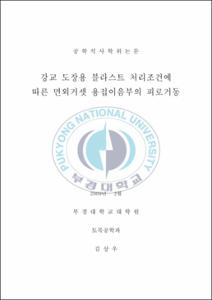강교 도장용 블라스트 처리조건에 따른 면외거셋 용접이음부의 피로거동
- Alternative Title
- The Effect of Blast Treatment Condition for Steel Bridge Painting on Fatigue Behavior of Out-of-Plane Gusset Welded Joints
- Abstract
- 본 연구에서는 면외거셋 용접이음부를 대상으로 용접 그대로의 시험체와 1회, 2회, 3회, 4회 블라스트 처리를 실시한 총 5종류의 시험체에 대한 피로시험을 실시하여 강교 도장용 블라스트 처리조건에 따른 용접이음의 피로거동을 검토하였다. 본 연구로 얻어진 결과를 정리하면 다음과 같다.
(1) 블라스트 처리횟수의 증가에 따라 면외거셋 용접이음부의 용접토우부 비드접선각도는 거의 변화가 없었으나, 곡률반경은 용접 그대로의 시험체에 비해 1회, 2회, 3회, 4회로 처리횟수가 증가함에 따라 곡률반경은 각각 15%, 21%, 30%, 39% 증가하였다.
(2) 용접토우부 부근의 잔류응력 측정결과 블라스트 처리를 1회, 2회, 3회 실시한 시험체는 약 25~50MPa, 4회 실시한 시험체의 경우 약 300MPa의 압축잔류응력이 도입되었다.
(3) 피로수명은 블라스트 처리를 한 시험체의 경우 고응력범위에서 용접 그대로의 시험체에 비해 거의 차이가 없었으나 저응력범위에서는 증가하는 경향을 보였다. 동일한 응력범위에 대한 1회, 2회, 3회 처리 시험체의 피로수명은 거의 차이가 없었지만, 4회 처리 시험체의 피로한도가 증가함을 확인할 수 있었다. 피로한도는 용접 그대로의 시험체에 비해 1회 처리시 약 1.7배, 4회 처리시 약 2배 정도로 크게 증가하였다.
(4) 1~3회 블라스트 처리 시험체의 피로수명이 거의 차이가 없으므로 도장 전 블라스트 처리시 피로강도 증가를 위한 추가적인 처리 공정이 필요하지는 않다고 생각된다.
Since the late 1980s, the blast treatment has become an important process in the manufacturing of steel structures in Korea, its purpose is to remove the impurities on the surface of steel material and to enhance the adhesiveness of coating. Even though the blast treatment has been generalized, its influence on the fatigue behavior of welding joints has not been considered. In the fatigue test by the blast treatment on the out-of-plane gusset welded joint, the fatigue strength of specimen has increased by the blast treatment, and it was mainly because the geometric shape of welded toe was improved and the residual compressive stress was introduced by the blast treatment. In this result, as the geometric shape is improved and the residual compressive stress is generated greatly, it can be expected for the fatigue strength to increase. So, it is necessary to evaluate the correlation between the blast treatment condition and the residual compressive stress quantitatively.
In this study, for 5 types of out-of-plane gusset welded joint specimens including the as-welded specimen(AW), one-time, two-time, three-time, and four-time blast treated specimens (BT1, BT2, BT3, BT4) the fatigue tests were performed, and the fatigue behavior of welding joint according to the blast treatment condition for the steel bridge coating was checked.
To apprehend the geometric shape change of welded toe according to the blast treatment times, the flank angle and the curvature radius were measured along with the change of residual stress. As the measurement result of geometric shape, the flank angle showed little change, and the curvature radius increased by 15%, 21%, 30%, and 39% for BT1, BT2, BT3 and BT4 respectively when compared with the as-welded specimen. As the measurement result of residual stress, it was found that the tensile residual stress was reduced and the residual compressive stress was introduced near the toe by the blast treatment.
As the result of fatigue test, the blasted specimens showed no difference in the fatigue lifespan with the as-welded specimen in the high stress range, but increase in the low stress range. In the same stress range, BT1, BT2, and BT3 showed no difference in its fatigue lifespan, but BT4 increased in its fatigue lifespan and fatigue limit. The fatigue limit of BT1 was 1.7 times and that of BT4 was 2 times as high as that of as-welded specimen.
- Issued Date
- 2009
- Awarded Date
- 2009. 2
- Type
- Dissertation
- Publisher
- 부경대학교 대학원
- Alternative Author(s)
- Kim, Sang-Woo
- Affiliation
- 부경대학교 대학원
- Department
- 대학원 토목공학과
- Advisor
- 이동욱
- Table Of Contents
- 1. 서론 = 1
1.1 연구배경 및 목적 = 1
1.2 연구범위 및 방법 = 4
2. 피로파괴 = 5
2.1 피로파괴의 기초 = 5
2.1.1 반복하중과 수명 = 5
2.1.2 피로수명 = 7
2.1.3 S-N선도 = 8
2.1.4 피로파괴의 파면 특징 = 9
2.2 피로강도의 제 인자 = 11
2.2.1 응력비가 피로강도에 미치는 영향 = 11
2.2.2 잔류응력이 피로강도에 미치는 영향 = 12
2.3 용접연결부의 피로설계기준 = 17
2.3.1 도로교설계기준의 피로설계기준 = 17
2.3.2 각국의 피로설계기준 = 20
2.4 쇼트피닝 가공 = 21
2.4.1 쇼트피닝의 기본 개념 = 21
2.4.2 쇼트피닝 가공의 장점 = 23
2.4.3 쇼트피닝에 의한 압축잔류응력 = 25
2.4.4 피로하중에 의한 잔류응력 변화 = 27
2.5 쇼트 블라스트 처리 = 29
2.5.1 쇼트 블라스트의 개요 = 29
2.5.2 표면 처리 및 하지 처리 = 31
2.5.3 쇼트 블라스트 매체 = 33
3. 피로시험 = 34
3.1 시험체 제작 = 34
3.2 시험방법 = 37
3.3 용접토우부 비드(bead)형상 및 잔류응력 측정 = 40
3.3.1 용접토우부 비드형상 측정 = 40
3.3.2 응력집중계수 = 43
3.3.3 잔류응력 측정 = 45
4. 피로시험 결과 = 49
4.1 피로균열 발생과 진전 = 49
4.2 피로수명 = 54
5. 결론 = 57
참고문헌 = 58
감사의 글 = 61
- Degree
- Master
- Files in This Item:
-
-
Download
 강교 도장용 블라스트 처리조건에 따른 면외거셋 용접이음부의 피로거동.pdf
기타 데이터 / 5.29 MB / Adobe PDF
강교 도장용 블라스트 처리조건에 따른 면외거셋 용접이음부의 피로거동.pdf
기타 데이터 / 5.29 MB / Adobe PDF
-
Items in Repository are protected by copyright, with all rights reserved, unless otherwise indicated.